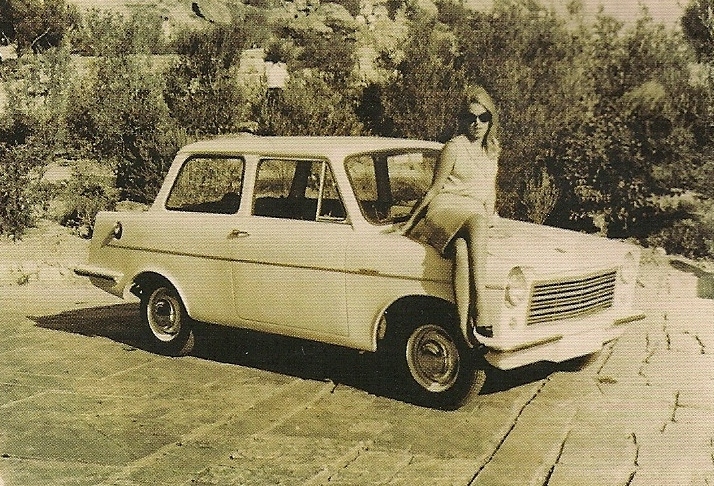Alta
Alta was a Greek manufacturer of light and heavier three-wheeler trucks, motorcycles and passenger cars. Production of motorcycles and three-wheeler trucks with Sachs 50cc engines started in its first factory in Athens in 1962. The 50S motorcycle model was known for its reliability (some survive to date in good working condition). In 1967 it designed and developed model A700, a heavier three-wheel truck with 2-cylinder BMW 35 hp engine and a payload of 800 kg. The truck, featuring a pleasant design and high reliability became one of the most successful vehicles of its kind in Greece. In 1968 Alta introduced a three-wheel passenger car, model A200 (three wheelers were classified differently according to Greek law). Powered by a Heinkel 200cc engine, the car was based on the German Fuldamobil (also produced by Attica in Greece under licence), but with Alta's own body design. The company moved production to a new, larger factory in Elefsis where it operated until 1978.
Attica
Attica was a brand name of vehicles produced by Bioplastic S.A., a company (originally involved in fiberglass panel manufacture, later expanding into fiberglass boat manufacture) created in Moschato, Athens by Georgios Dimitriadis, a figure in Greek automotive history.
Mr. Dimitriadis had designed and built a light four-wheel passenger automobile (model 505) in 1958 with the intent to produce it. A tax imposed on four-wheel automobiles at the time, though, limited the car's market prospects; thus, he abandoned that plan, focusing instead on the production of three-wheelers - taxed as "motorcycles" in Greece. In 1962 he started production of a light three-wheeler passenger car under licence of Fuldamobil of Germany as the Attica model 200 (it was much easier for cars certified abroad to receive certification for production in Greece). The car was built with few changes from the original German design, but later two different cabriolet versions were developed by Attica itself. 200 cc engines (by Sachs, Heinkel as well as engines built by Attica itself) were used to power different versions of the car.
The model became very popular in Greece and is remembered to this date. Another Greek company, Alta, soon claimed a market share in the same category, introducing a similar vehicle in 1968; this was also based on Fuldamobil technology but it was extensively modified, with a more modern design. Attica 200 was nonetheless produced until 1971. In 1968 Bioplastic utilized the Attica 200 design to create a light three-wheeler truck brand named Delta (oddly enough, the rear-half of the 200 had become the front-half of Delta!), sold with modest success.
In 1965 Attica had already made an effort to enter the market of four-wheel automobiles, introducing the Carmel 12; the car was built under licence of Israeli Autocars company (which, in turn, had used British Reliant technology). In fact, the term "manufacture" is probably not appropriate in this case, as most parts were imported. Despite a publicity campaign, the car did not sell well and only about 100 Attica Carmel 12's were actually produced. In 1977 Dimitriadis transformed Bioplastic into a new company (DIM Motor) to produce the DIM, an entirely new passenger automobile designed and developed by his company. The car was presented in the Geneva Motor Show in 1977 but its life was very brief: only a few were produced.
DIM
DIM Motor Company, a Greek automobile maker, was created by Georgios Dimitriadis as a successor to his earlier company, Bioplastic S.A., which had produced the Attica automobile. The DIM represented one more effort by Mr. Dimitriadis to design and develop a modern car entirely by his company's own means. A 400cc, air-cooled, 2-cylinder, 30-hp engine was also developed in-house to power the vehicle, but due to delays in the engine development, the car was introduced with a 600cc engine and other mechanical parts of the Fiat 126 model. A 650cc Fiat engine was also used, in an improved version. The car was finally introduced at the Geneva Motor Show in 1977, and for this reason received more publicity than most Greek vehicles, appearing in many international publications. All development work had been made in a factory intended for its production in Acharnes, while the company was advertised in the Greek press; plans were also made for more versions, including a sports coupe. However, the costs involved and the car's poor prospects in the Greek market (despite an effort to facelift the model) resulted in termination of production after only about ten had been produced. The whole project was abandoned in 1982, having been Georgios Dimitriadis' last venture in the automotive industry.
Dimitriadis 505
Dimitriadis model 505 was a Greek microcar developed in 1958 by G. Dimitriadis, founder of the Bioplastic boat and automobile manufacturer. This car represented his first effort in automobile production, and was presented in a number of exhibitions in Greece. According to Mr. Dimitriadis, its production was eventually considered non-profitable compared to that of three-wheelers (which were taxed much more favorably). Thus, he switched to the licence production of the German Fuldamobil three-wheeler (rebadged as the Attica).













.jfif)

No comments:
Post a Comment